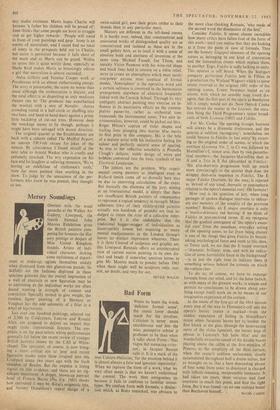Mersey Soundings
Just over one hundred paintings, selected out of 2,500 by Coldstream, Lanyon and Ronald Alley, are designed to deliver an impact that might strike international fanciers. The em- phasis is on the pace-setters whose performances generally fall below the recent review of younger British painters shown by the CAS at White- chapel. The spectator, of course, is now bring- ing a more critical eye to `pop' and recent figurative modes since these irrupted into this Liverpool arena two years ago with the fresh abandon of Beatles. But the impulse is losing vigour on this evidence, and there are no sig- nificant departures. A sloppy, blown-up portrait head of Francis Bacon (Pin Up, I563) shows how enervated it may be. Kitaj's enigmatic trio, and Antony Donaldson's repeat design of a swim-suited girl, p.we their prizes rather to their brands than to any particular merit.
Matters are different in the left-hand rooms. It is hardly ever, indeed, that constructivist and associated works of distinguished quality are so concentrated and isolated as these are in the small gallery here, as to instil it with a sense of absolute hush and alertness of invention at the same time. Michael Fussell, Joe Tilson, and notably Victor Pasmore with his wine-red shape and black lines held in tension on a white relief, serve to create an atmosphere which must surely overpower anyone most sceptical of formal modes. `Atmosphere' is the operative word and a certain saltiness is conveyed in the harmonious arrangement elsewhere of abstracts frequently linked with the Cornish School. Through its very' ambiguity abstract painting may exercise an in- fluence in its associative effects on the contem- plative passer-by, rather as orchestral tone transcends the instrumental notes. Two sure in- strumentalists, however, could be picked out fire. Roger Hilton's caprice of violet shapes and trailing lines plunging into marine blue merits its first prize in this company. His is the brio of a mature artist with his instinctive feeling for colour and perfectly natural sense of spacing. As true to her reflective sensibility is Prunella Clough's delicate, stable design of wires and bobbins converted into the basic symbols of her Electrical Landscape.
The juniors are the problem. Why experi- mental young painters as intelligent even as Richard Smith come off so dismally here may be due to unnerving calculations of the event. But basically the dilemma of the jury, aiming at an international model, is simply that there are insufficient British painters of consequence to represent a topical tendency in strength. Minor adherents (two of their slickly-styled patterns actually win hundreds of pounds) are thus in- _ dulged to create the eclat of a collective enter- prise. But it is also undeniable that the. traditional hugger-mugger of individualists as incorruptibly honest but requiring as many mental readjustments as the London Group's leaves no distinct impression whatever. There it is thew Cleared of sculpture and graphic art, this Liverpool Biennale offers an uninterrupted view of current native painting in its own dis- tinct and heady if somewhat specious terms, to give Mr. Moores much to ponder before 1965 when there might well be sculpture only, out- size, no doubt, and very far out.
NEVILE WALLIS


































 Previous page
Previous page